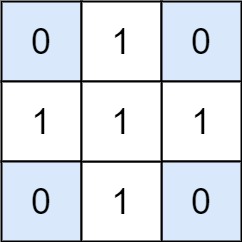Problem
Given a matrix and a target, return the number of non-empty submatrices that sum to target.
A submatrix x1, y1, x2, y2 is the set of all cells matrix[x][y] with x1 <= x <= x2 and y1 <= y <= y2.
Two submatrices (x1, y1, x2, y2) and (x1', y1', x2', y2') are different if they have some coordinate that is different: for example, if x1 != x1'.
Example 1:

1 | Input: matrix = [[0,1,0],[1,1,1],[0,1,0]], target = 0 |
Example 2:
1 | Input: matrix = [[1,-1],[-1,1]], target = 0 |
Example 3:
1 | Input: matrix = [[904]], target = 0 |
Constraints:
1 <= matrix.length <= 1001 <= matrix[0].length <= 100-1000 <= matrix[i] <= 1000-10^8 <= target <= 10^8
Analysis
题目给出一个矩阵,还有一个目标值target,要求找出所有和为target的子矩阵的数量。暴力的解法是穷举出所有的子矩阵,然后每个都算一次和,与target值对比一下。这种做法最大的问题是重复计算了很多中间情况,那么优化的思路也很明显,我们把中间计算的结果存起来就好了。
显然一下子处理矩阵的中间计算值不太好处理,我们先从一个维度开始,先计算每一行的中间值。我们对每一行做presum计算,即row[i]表示的是这一行区间[0,i]的所有数之和。有了每一行的presum之后,我们就能很方便地计算区间[i,j]的值,为row[j] - row[i - 1]。
解决了每一行的问题,我们就可以来看矩阵的问题。我们只要限定左右边界,从上到下遍历,就能够计算出这个左右区间里面,从上到下矩阵的presum。但这个值我们就不需要再用一个数组去存了,可以直接存入map中,每次用sum - target看看是否在map中,如果在的话,说明符合要求的矩阵的数量+1。这里有点不好理解,举个例子,假设target = 1,如果从上到下矩阵的presum是[1,2,3,4],那么在第一个的时候,sum - target = 0,同时把sum = 1存入map中;处理第二个的时候,sum - target = 1,在map中能找到,同时把sum = 2存入map中,以此类推,这样也算是在纵轴方向上的一个计算优化。
Solution
需要特别注意,在限定左右边界时要注意边界情况。这里我为了便于理解,开presum数组时多开了一列,所以是某个区间的和是presum[col2] - presum[col1]。同时还要注意,map初始化的时候要预先存入<0,1>,这个是直接满足答案的条件。
Code
1 | class Solution { |
Summary
这道题目难度比较大,主要的原理还是presum,只不过换成了二维的方式。主要的思路还是先求出每一行的presum,然后限定好左右边界,再从纵向presum求和处理。这道题目的分享到这里,感谢你的支持!

